Technology promises a world of convenience where tasks are automated, information is readily available at our fingertips, and the boundaries of time and space appear to blur. It has undoubtedly facilitated our lives in numerous ways, making communication, work, leisure and, of course, the creation of art more efficient and accessible. But this technological ubiquity has a darker side to it. As we become increasingly tethered to our devices, we risk losing touch with the subtleties and sensory experiences that define our humanity. Moreover, it is worth questioning how the digital realm impacts our memories and personal narratives. The convenience of externalizing memories through digital storage may inadvertently lead to a depreciation of our own ability to remember and relive our experiences organically, just as the tech itself is, in time, subjected to generation loss. In this era of unprecedented technological influence, it is imperative that we navigate the intricate relationship between technology and attempt to strike a balance. As we embrace the conveniences of tech, we must also remain vigilant in preserving the intrinsic qualities that define our humanity and the depth of our collective memory.
Expanding on last year’s theme, “The Changing and The Indeterminate”, the 2023 edition of SIMULTAN festival proposes a reflection on oscillations, undoubtedly a leitmotif of contemporary existence. From pandemics, to wars, to climate change and general societal unrest, we’ve become accustomed to oscillating between the horrors of the real world and the numbing, dopamine inducing bright screens of our devices. But what do these oscillations sound like, how does their rhythm ring and how do they harmonize with our own interior pulsations? And, more importantly, what remains in-between the oscillations? What can we gather from there?
“Oscillation serves as a foundational principle in understanding and interacting with our world. From the smallest atomic vibrations to the grandest cosmic movements, oscillation shapes our experiences, communication, and technological advancements. Recognizing the significance of oscillation in our lives can deepen our appreciation for the complexities and beauty of the natural and technological phenomena that surround us. Our senses, such as sight, hearing, and touch, rely on oscillatory patterns to interpret the world around us,” details Levente Kozma, co-founder and curator of SIMULTAN, in the curatorial statement.
These are some of the questions tackled by the visual and sound artists of SIMULTAN 2023, which took place in early October. Titled “Oscillations. Things to remember”, the event celebrated 18 years of existence and activity and took place at the “Corneliu Miklosi” Museum and the former workshops of the Timișoara Public Transport Society – conceptually united within the same event for the first time since their reconversion into the future Center for Art, Technology, and Experimentation – MultipleXity (MX).
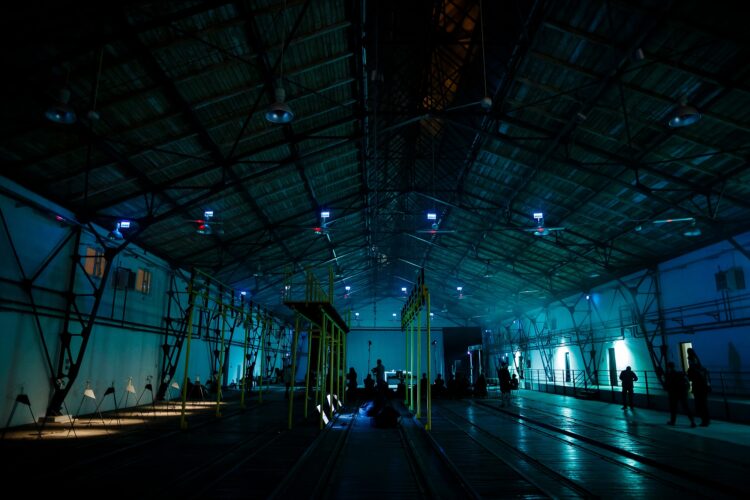
Simultan Festival 2023 – Photo: Cornel Putan
Space plays an important role in the viewing/listening experience. This year, the open space of the museum was envisioned to be an exhibition space for the videos, art installations and workshops by day, and a concert hall by night. This modular approach aimed, perhaps, at intersecting the two general audiences of the festival, the art crowd and the music aficionados. SIMULTAN’s organizers has always been aware of this divide and have come to embrace it, in the past often setting up separate venues for art and sound, and workshops and conferences as a means to bridge the two. The 2023 setup, however, with all of the events scheduled in one place, makes it more convenient for visitors to fully experience SIMULTAN’s vast artistic menu.
SIMULTAN by Day
Beginning with the customary open call for video works, each year, the festival takes on the arduous labor of sifting through hundreds of submissions and creating a sensible curatorial selection. Films by local artist Alexandra Coroi, Adrian Ganea and taietzel ticalos to name a few, were screened alongside works by Patrick Topitschnig, Adam Sébire, Jingyi Wang and many other international creators on six screens and projections scattered throughout the “Corneliu Miklosi” Museum. Visitors could view them at their leisure and immerse themselves in vivid digital vistas with its uncanny appearance oscillating between the real and fictional – impeccable 3D renders, realistic textures, impossible yet recognizable architecture –, laugh at humorous video collages or shudder at unsettling real-life stories, and even sway to hypnotic beats and experimental cadencies of some of the video works – in which sound generates abstract images.
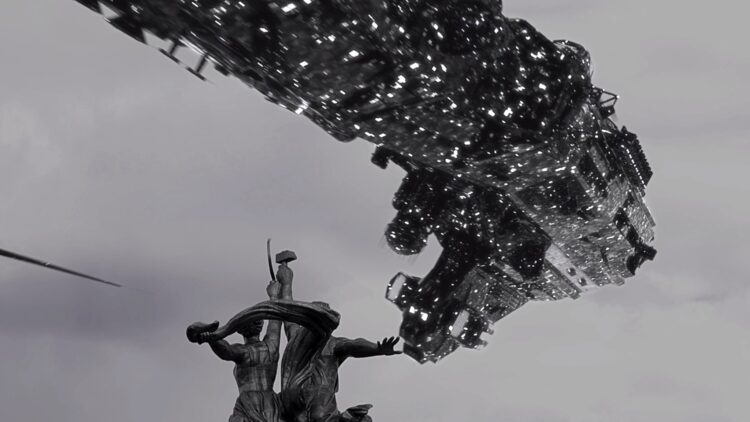
Katherina Sadovsky (Russia) – Rage (2023)
Indeed, sound and image – in this order – form the gray area in which SIMULTAN operates, showcasing its most relevant artists. Ioana Vreme-Moser is perhaps the festival’s most championed performer, whose entire career was shaped by SIMULTAN. A true transmedia artist, managing to find the subtle balance between the audible, the visual and, sometimes, even the tactile to explore and process various materialities of sound. Her works, ranging from performances to installations, center around electronic components – the sounds they make, how they interact with her body, what they are made of, their history, production chain and subsequent entanglements in the natural world.
Ioana’s Mineral Amnesia installation illustrates the progression and deterioration of the outdated microchip, tracing a visual history of obsolescence. Interactive EPROMs from various generations, containing snippets of sounds – their tiny memories only hosting a short expression or even a single spoken word – were exhibited under UV lights, slowly eroding over the festival’s run time with each play prompted by the visitors. The installation conceptually extends into her Sizzling Semiconductors workshop (developed prior to the event) and the performative lecture Screaming Minerals. This performance opened the 2023 edition of SIMULTAN and served as the perfect introduction to the multiple concepts proposed by the festival. Starting as an ordinary, yet fascinating presentation on the various metals and elements used as semiconductors throughout history, the lecture takes an experimental turn as Ioana’s crystal clear voice begins to modulate and break. Radio static, clicks and hisses soon take over the speakers and the focus shifts from the presentation screen to the workshop participants, appearing seemingly out of nowhere, operating small, rudimentary devices they crafted themselves.
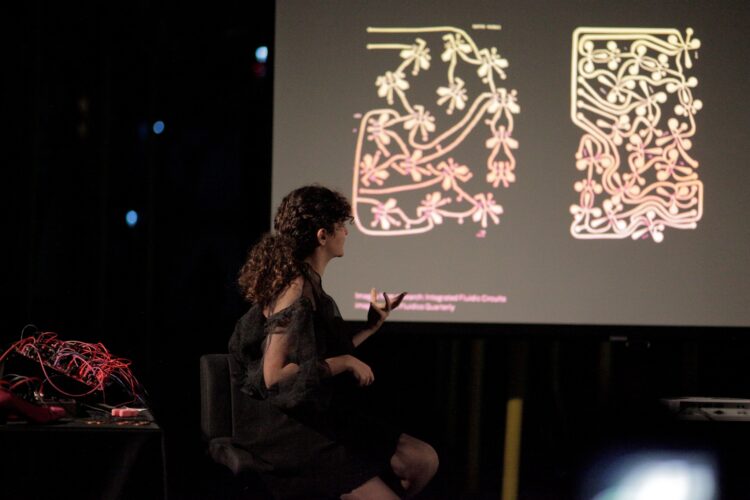
Ioana Vreme-Moser – Screaming Minerals — Lecture performance – Photo: Andreea Săsăran
This opening performance ties in nicely with the festival’s underlying theme, Things to remember, inviting the public to contemplate the concept of tech fossils and the ever-growing trend of programmed obsolescence and conceptually segues into the other two art installations exhibited in the museum.
Welcome to the Relative End of the Road not Taken! by Andrei Dinică, Mihai Drăgan and Sabina Suru is a collaborative anti-interactive artistic installation – a dark room with a shiny black floor and three monitors. A grainy, noisy image of what appears to be antiquated lab tech oscillates from one screen to another, while a mechanical turtle drudges itself along the floor, crawling away from any spectator. The use of old tech, echoed in Ioana Moser’s work, paired with the lazy, shy turtle suggests a kind of temporal bubble, where the dizzying advances in technology and science are suspended in time.
The idea of temporal eras is further explored by Andreea Medar and Mălina Ionescu in their video/installation Land Under Wave, also exhibited at the museum. Mălina and Andreea have been working as a duo for many years now, and their collaborative works often center around unearthing geological layers of meaning in various areas of Romania. From the green terrains of Hațeg to the urban delta of Bucharest, their current research takes them to northern Craiova. Here, the two artists have encountered unusual fossils in the gardens of locals, who use them as fertilizer, convinced of their exceptional alkaline properties. The installation consists of a video in which the artists, accompanied by geologist Vlad Iorgoni, sift the soil and engage the locals in a conversation about the treasures hidden beneath their feet, hinting at the possibility that a vast sea was once there. Some of the fossils are exhibited alongside the video for the public to inspect – a reminder that although the world is moving at an alarming speed, the persistence of ruins and fossils encourage us to slow down.
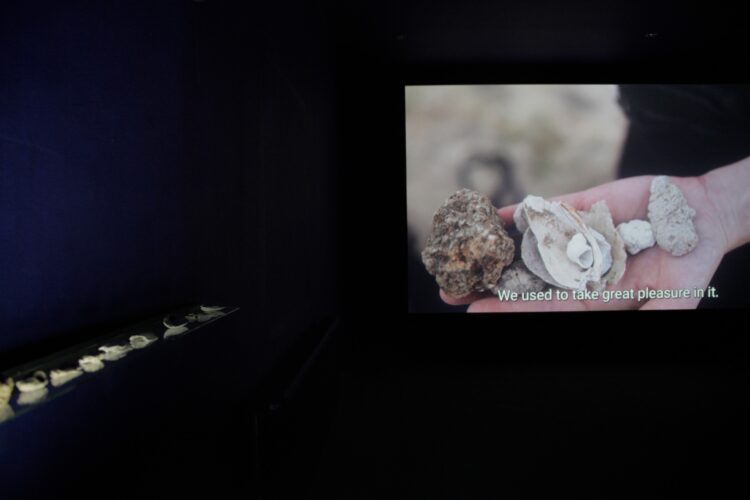
Land Under Wave — a research based project and installation by Andreea Medar & Malina Ionescu – Photo: Andreea Săsăran
Across the street, at The Former STPT Workshops, Michal Mitro’s Edge of Chaos echoes all the way to the museum, suggesting a different type of persistence. The overgrown grounds of the old workshops ring with sharp noises, coming from one of the two hangars, now converted into art spaces. Inside, a pulsating string of led lights gather above a set of beautifully custom crafted speakers that emit ear-piercing shrieks of audio feedback. This noise appears to be random and quite unwelcoming, yet at a closer inspection, it is directly influenced by the sounds of visitors pacing around the room. Edge of Chaos mirrors the chaos of everyday life and the oppressive systems that govern it from the shadows. An individual might feel overwhelmed by the harsh sounds of this installation, but a group of people has the potential to overpower the suffocating noise through their presence alone – an invitation to contemplate on the individual-collective dichotomy – yet another oscillation.
In the adjacent space, this oscillation is reframed as a self-reflective process. Emilia Păunescu’s All in One, a spectacular immersive interactive experience, offers a cinematic depiction of anxiety, illustrating the various ways it manifests in our bodies, translating relevant neural research data into sound and image. Anxiety is indeed recognized as a prevalent and a chronic state of being for many individuals. Fittingly, AIO invites the audience to an intimate and even disquieting experience. The multi-screen set-up of the installation remains inactive until the spectator initiates the artwork via a simple interface, selecting the intensity level for the represented emotional states. The musical component of the installation is derived from translation of EEG signals into musical notes, while the video elements serve to humanize the overall experience, functioning as a conduit for emotional expression. This is achieved through the facial expressions, gestures, and movements of a number of characters, effectively conveying different levels of anxiety.
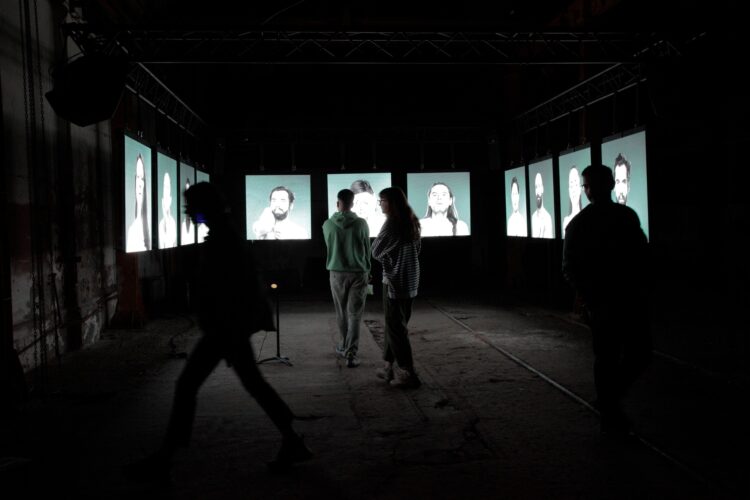
AIO – ALL IN ONE — an immersive and interactive installation – Photo: Andreea Săsăran
To conclude the day-time portion of SIMULTAN’s scheduled events and, of course, to smoothly transition to the sound-performance portion of the event, two other workshops framed art and technology in a pedagogical manner. Similar to Ioana Vreme-Moser’s performance-lecture, Signals of Uncertain Path by Neja Tomšič and Mihai Toth presented the first iteration of a larger project in the field of early histories of computing. In this performance, Tomšič and Toth look at relations between human bodies and machines and enact the laborious process of operating computers. They vividly depict the arduous and demanding nature of machines, also evoking the unseen work of women, who were, up to the 1980s leading innovators and forces in computing.
In Cătălin Creţu’s more conventional workshop, his approach to sound and tech suggests looking into the future, rather than the past. Creţu, a composer with an engineering background, uniquely draws inspiration from sound and invites his audience to do the same. He transposes calculations into auditory experiences, openly describing the intricacies of his creative process, shedding light on the specialized software and frequencies integral to his works. Notably, Creţu’s enthusiasm permeates his discussions, as he passionately articulates the symbiosis of technology and artistic intuition, revealing a deep engagement with the underlying structures and mathematical complexities that define his musical language.
SIMULTAN by Night
As contemporary musicians take the SIMULTAN stage and the museum becomes a concert hall, it is important to note that these performances sometimes make for a difficult listen, lacking traditional form, rhythm, or repetition. The experimental music portion of SIMULTAN can be described as an “acquired taste”. But, as Creţu highlighted in his presentation, making the “effort” of experiencing inaccessible music encourages open-mindedness, patience and appreciation for a wider array of sounds, especially the subtleties of sound textures or the novelty of unusual sounds. After all, why not oscillate between familiar tunes and rhythms outside one’s comfort zone?
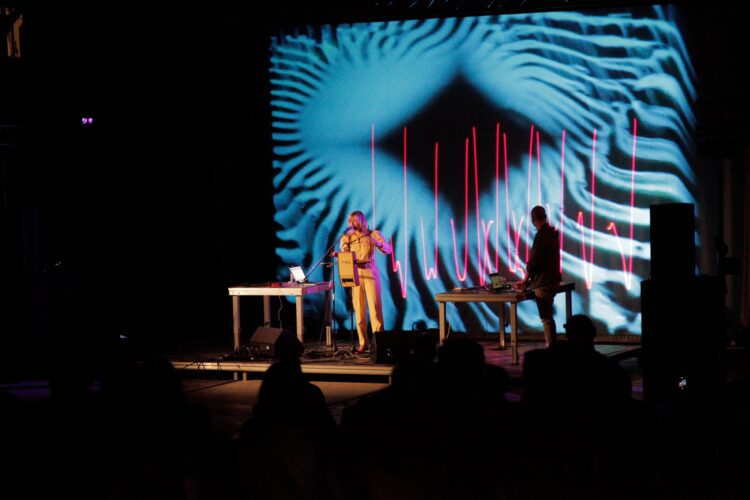
Dorit Chrysler and Alberto Novello
That being said, some performances are more palatable than others, in particular the audio-visual live shows. Composer and musician Dorit Chrysler and visual artist Alberto Novello deliver a candid and warm performance, transporting the audience to ethereal and otherworldly realms reminiscent of earlier decades. The musician’s minimal wave-like tunes take a darker turn, with the intuitive manipulation of the theremin adding a unique and haunting dimension to the overall sonic landscape. Notably, her rendition of Donna Summer’s I Feel Love stands out as a captivating cover, further showcasing Dorit’s ability to infuse classic elements within a contemporary showcase.
In the collaborative effort between sound artist Jasmine Guffond and visual artist Ilan Katin, their performance unfolds as a slow and warm auditory experience accompanied by shifting digital shapes, signifying a new digital dawn. This sonorous narrative takes the audience on a journey from tranquility to the rumble of urban living, punctuated with sonic chirps directed at a single speaker at a time. The screen becomes inundated with forms, creating a graphical visually immersive experience, sonifying surveillance data gathered by Guffond in her research. Similarly, in their audio-visual performance, Simina Oprescu, Cosmin Nicolae, and Matei Băcanu investigate the diasporic condition – the artists are all Romanian born, but live and work in Berlin. Through the evocative use of electronic bells and chimes, the artists explore the complexities of not belonging and the transitory nature of spaces. Utilizing grids, oscillating maps and AI aesthetic imagery, the performance unfolds as forms traverse various landscapes, accompanied by an uneasy countdown embodied by clocks. The generative images seamlessly intertwine with rhythmic sounds, giving rise to the emergence of strange cities and structures.
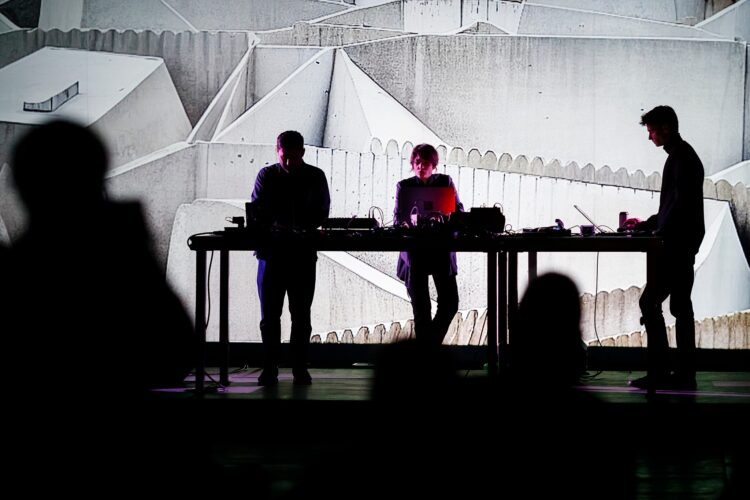
Simina Oprescu, Cosmin Nicolae, and Matei Băcanu – Photo: Cornel Putan
These performances, imbued with visuality, showcase the seamless ebb and flow of sound, making for a captivating and multisensory exploration. Another sound artist that makes use of images as support for his sound experiments is Simon Whetham, albeit in a different manner. Utilizing hard drives emitting whirring noises reminiscent of gurgles from inside a stomach, Whetham works with all sorts of dated devices that produce sound while projecting them on screen. Mechanical devices, including various types of motors and amplifiers, produce a rattling symphony, with coils and old technology put together out of scavenged moving parts. The artist ingeniously recycles these devices, creating a unique auditory landscape that blurs the lines between man-made and found elements.
In this sense, many of the sound artists and musicians to grace the SIMULTAN stage this year do not employ visual aids and are in a constant resonant exploration, pushing their “instruments” to their limits in instant musical compositions. Experimental musician Svetlana Maraš crafts a distinctive sonic experience characterized by trembling motion and noisy glitchy sounds. She skillfully produces broken electronics through touch, weaving a haunting soundscape enriched with electric rain and thunder-like noises. Known for her work with prepared percussion instruments, Maraš creates compositions that are rich in textures and makes use of microsamples to further enhance the depth and complexity of her creations.
SIMULTAN is no stranger to haunting and brooding atmospheric performances, such as that by Ana Fosca, a mesmerizing cathartic incantation that embodies pain and despair, delving into the realms of dark drone and noise. Her compositions unleash earth-shattering, deep vibrations, evoking an end-of-the-world-esque feel. Fosca ventures into the dark corners of the earth, conjuring auditory imagery akin to smoke billowing from a witch’s cauldron. Over time, the sound, a continuous modulation, evolves into something even more ominous, shaking the entire venue with its powerful presence. In the same vein, Jacqnoise crafts a ritualistic auditory experience through disjointed voices and the deconstruction of various sounds. Synchronized with her surroundings, her work unfolds with long, haunting tunes that carry a somber quality. Oscillating between moments of stillness and low hums, akin to the shifting of tectonic plates, her composition sometimes resembles the beating of an electrical heart.
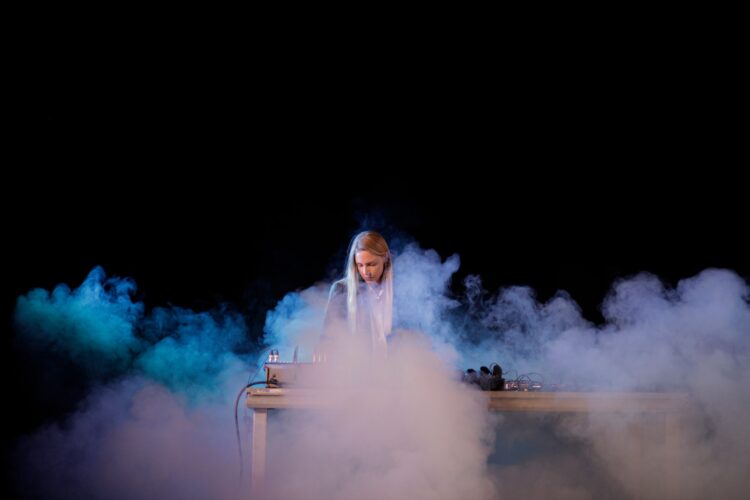
Ana Fosca
The same soul-stirring quality was felt in composer Robert Piotrowicz’s symphony of disjointed organs, showcasing a mastery of unique and unconventional tunes. Having performed at SIMULTAN before, at the Synagogue, his compositions weave together weird harmonics, creating an atmosphere reminiscent of a haunted dollhouse. Utilizing accordions, harmonicas and other air instruments alongside plunderphonic tunes, Piotrowicz skillfully mimics the sounds of organs, with his innovative approach extending to crafting new instruments out of various devices.
Arguably one of the most difficult listening sessions of the festival, musician Thomas Ankersmith delves into experimental sound design with his use of the synthesizer serge modular, a device that carries little traditional musical heritage, but rather serves as an open sound laboratory. His approach is wholly analog, devoid of samples and digital oscillators, resulting in an array of feedback and noise generators colliding with one another, akin to the explosive sounds of a warzone. Without additional effects or equipment, Ankersmith crafts novel sounds that defy the familiarity of traditional instruments, creating a dark and atmospheric mood. Oscillating between moments of silence and loud noise, his electronic sounds, reminiscent of insects, morph into the anticipation of a bomb drop, introducing a spatial element that mimics proximity and distance. An eerie presence appears to follow the listener, making this experience not for the faint of heart – a challenging yet immersive journey through oscillations that resonate deeply.
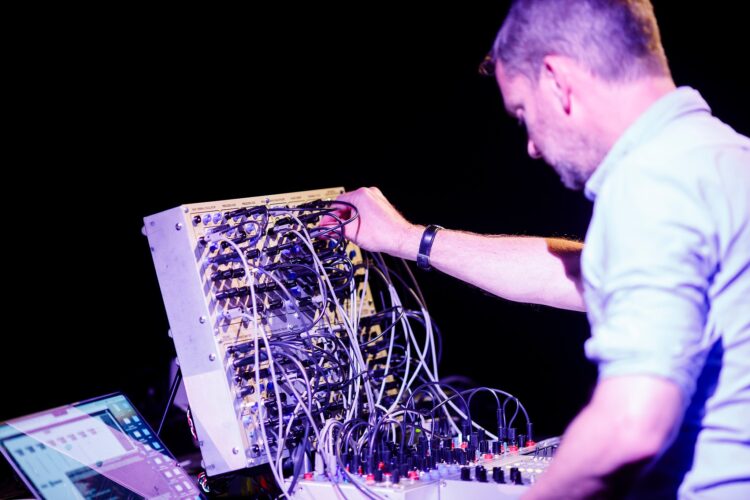
Thomas Ankersmit – live performance – Photo: Cornel Putan
SIMULTAN’s headlining acts, as it were, had to be Ilpo Väisänen and musical act hÄK / Danzeisen, potentially the festival’s fan favorites. Väisänen, renowned for his collaboration with Mika Vainio in the Finnish duo Panasonic/Pan Sonic, stands as a pivotal figure in contemporary electronic music. His solo work is characterized as permanently fluctuating between hot and cold; composed of creaks, whistles, strange noises and rhythmic improbabilities. His performance begins with alien, unearthly tunes, exemplified by a modulated ancestral scream oscillating between electrical and eerily human. Gradually, this sonic journey evolves into a rhythmic cadence, assuming an almost clubby feel with tribal undertones; one almost feels like dancing. The experience, however, concludes much like its inception, as if the mothership is once again departing, leaving behind the remnants of an otherworldly auditory encounter.
The musical duo hÄK/Danzeisen boldly challenges traditional instrument roles, delving into the realm of a new musical language. Their performance interconnects Danzeisen’s powerful drum rolls and the sound modulations of Bernd Norbert Würtz alias hÄK, creating a dynamic experience that constantly oscillates between the registers of “composed” and “improvised.” As SIMULTAN’s sole live band and closing act, they deliver a compelling blend of drum beats and noise that starts off robustly. With synths reminiscent of electric guitars, their set bears a striking similarity to the pioneering sound of This Heat, evoking a modern synth punk ethos. The duo provides a great send-off for the festival, leaving an indelible mark with this boundary-pushing show that got everyone head-banging.
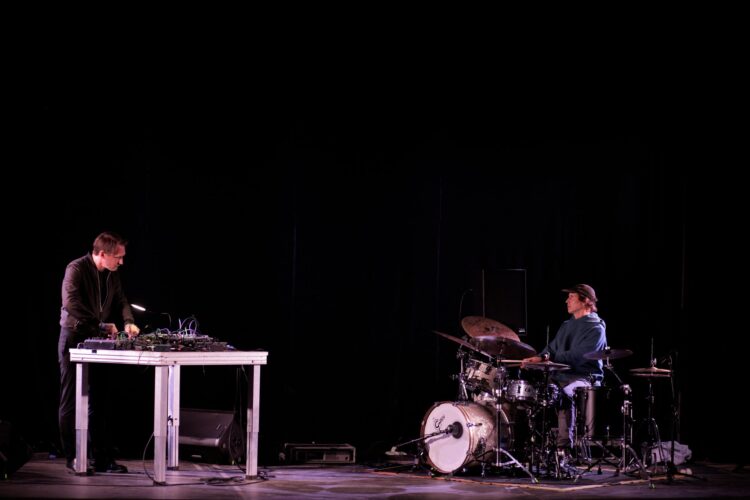
HÄK : Danzeisen — Live performance – Photo: Andreea Săsăran
These types of sonic performances are quite rare in the Romanian cultural landscape, as experimental music has yet to fully find its voice within the local art scene. As previously mentioned, it takes a certain type of sensibility that is harnessed in time in order to be able to truly appreciate them. As such, SIMULTAN’s continuous efforts to showcase such diverse and moving artistic experiences, especially in the realm of sound art, are beyond praiseworthy. For 18 years now, this festival continues to create the physical and mental space for becoming receptive to the act of listening, especially to unconventional or demanding soundscapes. It encourages individuals to transcend preconceived notions of what constitutes “pleasant” or “acceptable” in the realm of sound, cultivating a broader perspective on auditory aesthetics.
“Rarely selective, reception occurs in a configuration in which input, which is mobile, is highly susceptible to feedback. It can become output and vice versa, in short cycles: as reverberations, echoes, reflections on screens, down narrow pathways, passages, gorges, defiles, impasses, frequent and unexpected bifurcations, circuits – think of a scrambled computer chip – creating specific points where the captive energies are lobbed back and forth. Reception is structured as self-transmission, it tames the unfamiliar, just as we repeat new words to ourselves in order to assimilate them.”[1]
[1] Serres, Michel, (2008). “Boxes”: The five senses : a philosophy of mingled bodies, translated by Margaret Sankey and Peter Cowley (p. 140). London; New York: Continuum.
* This journalistic material was produced with the support of an Energie! Creative Grant awarded by the Municipality of Timișoara, through the Center for Projects, within the Power Station component of the National Cultural Program “Timișoara – European Capital of Culture in the year 2023”.
The material does not necessarily represent the position of the Center for Projects and the latter is not responsible for its content or how it may be used.
POSTED BY
Marina Oprea
Marina Oprea (b.1989) lives and works in Bucharest and is the current editor of the online edition of Revista ARTA. She graduated The National University of Fine Arts in Bucharest, with a background i...
marinaoprea.com

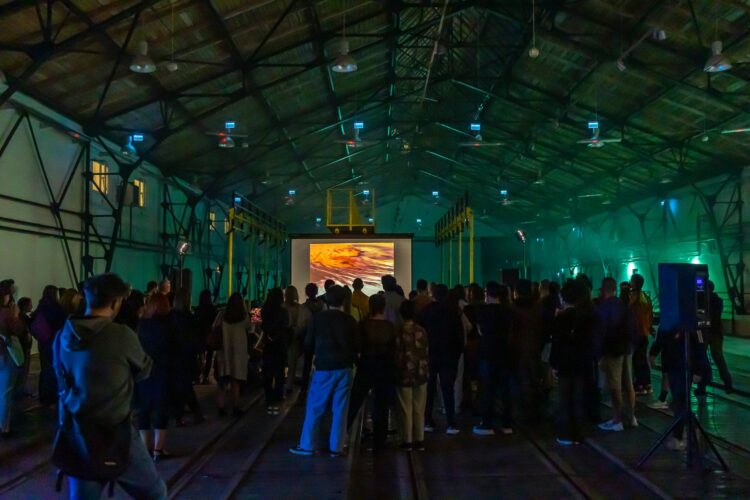
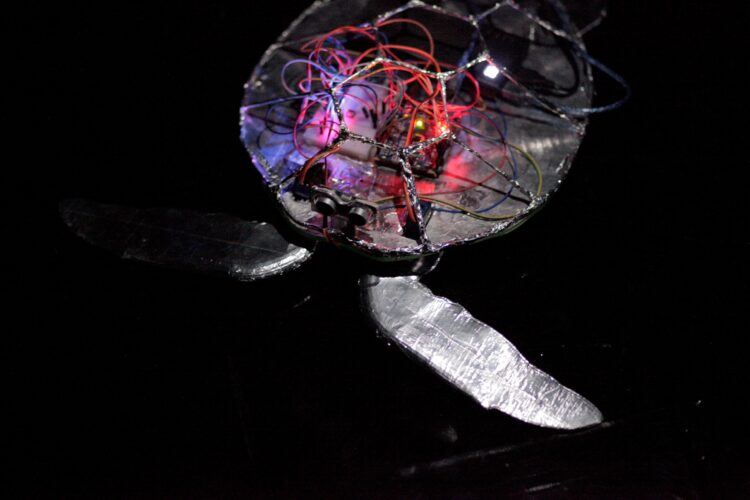
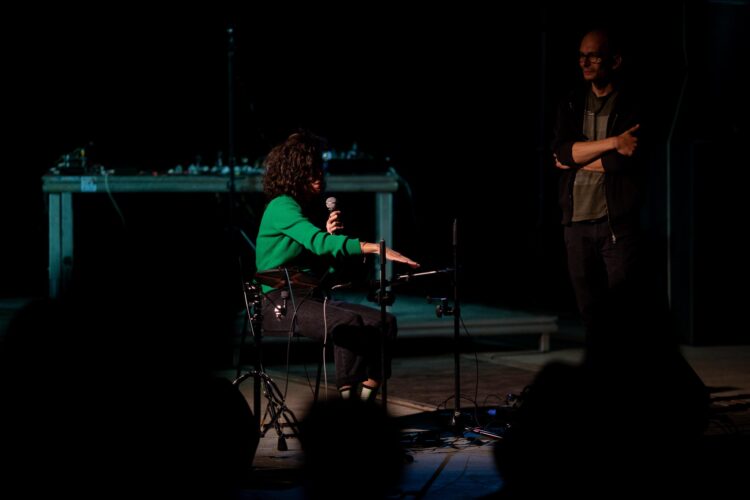
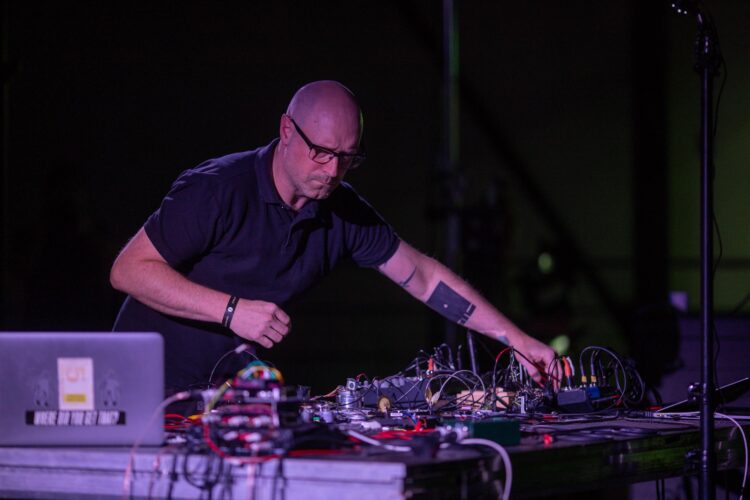
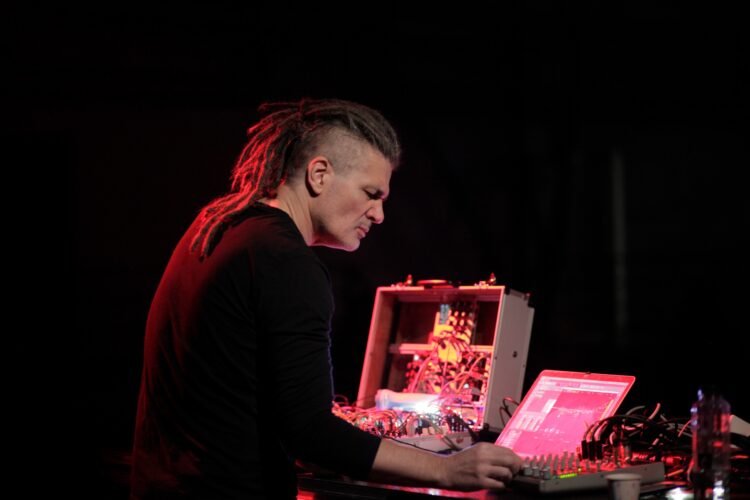
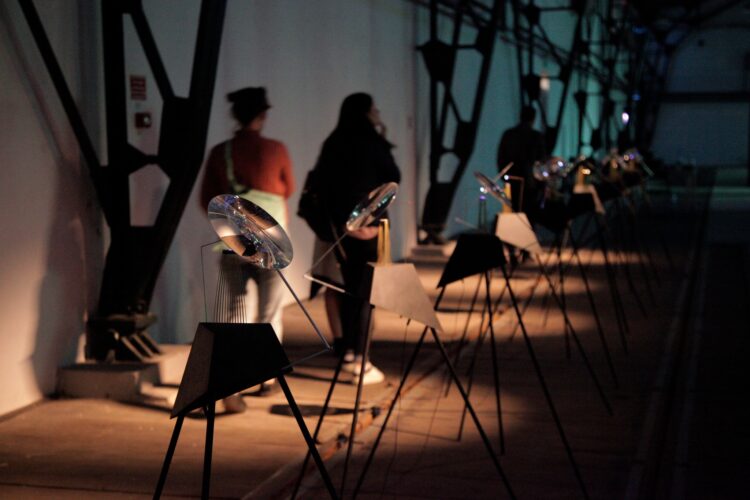
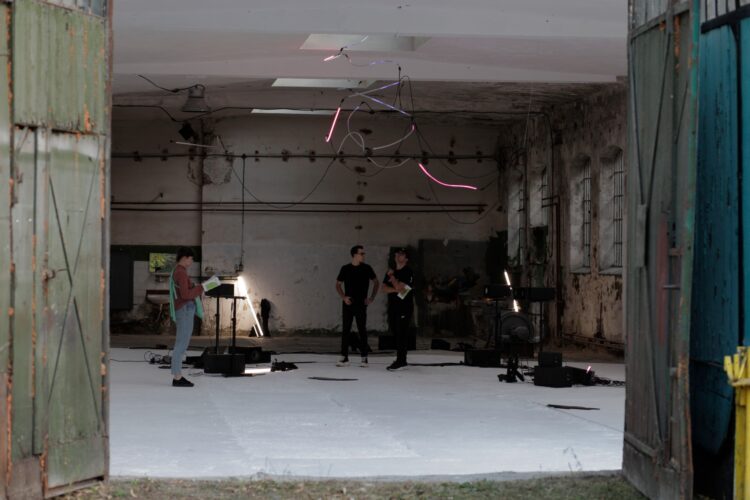
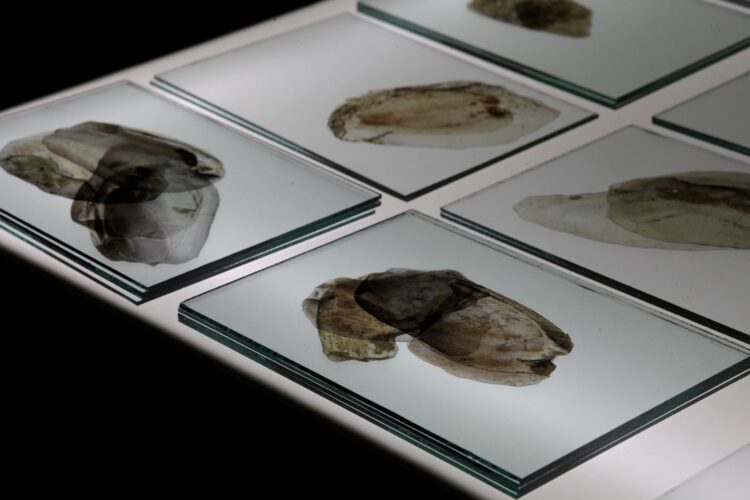
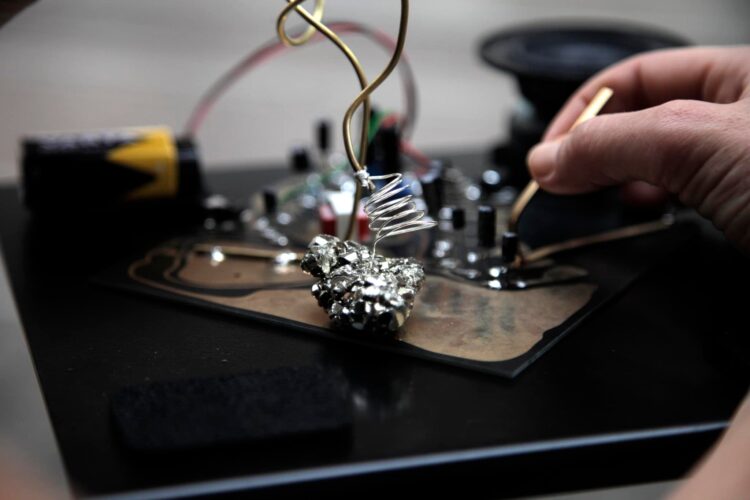
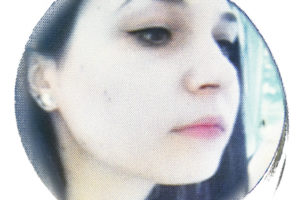
Comments are closed here.